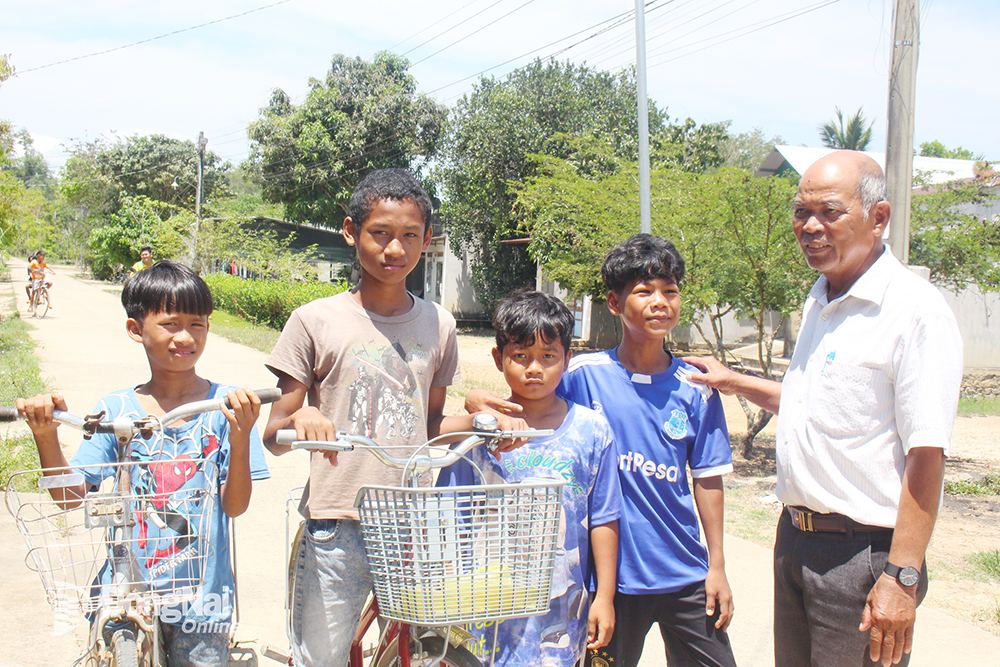 |
| Ma and Stieng children and prestigious person K'Can (Stieng ethnic group, residing in Hamlet 4, Ta Lai commune, Tan Phu district) on a spacious and clean village road. Photo: D.Phu |
Ma and Stieng people unite and love their country
Mr. K'Luan (Ma ethnic group, Head of the Front Work Committee of Hamlet 4, Ta Lai commune) said that in the past, the Ma people called Ta Lai as R'lai village. In 1994, Ta Lai commune was separated from Phu Lap commune. The land of Hamlet 4, Ta Lai commune still retains the cultural and historical traces of the Ma and Stieng ethnic groups from long ago. The solidarity between the Ma and Stieng ethnic groups and other ethnic groups is still strengthened.
Hamlet 4, Ta Lai commune has 487 households with nearly 2,000 people, of which the Ma and Stieng ethnic minorities make up the majority with over 370 households. Before the August Revolution in 1945, R'lai village of the Ma and Stieng people was surrounded by vast forests and mountains, isolated from the outside world. Based on this danger, the French authorities built a prison to detain patriots. The French colonial government called the detention facility Camp des Travailleurs Talai. Those imprisoned here called it "Cang Ta Lai" or "Special Labor Camp".
According to the History of the Ta Lai Commune Party Committee, on March 27, 1941, imprisoned revolutionary soldiers, including 8 party members: Duong Quang Dong, Tran Van Giau, Tran Van Kiet, Truong Van Nham, Nguyen Van Duc, To Ky, Chau Van Giac and Nguyen Cong Trung, with the help of ethnic minorities, escaped from prison, avoiding the fierce pursuit of the French colonialists to return to their localities to continue leading the revolutionary movement.
This historical event is preserved through the Monument Cluster (established in 2002), the Stele marking the escape from Ta Lai prison on the night of March 27, 1941, lying peacefully by the Dong Nai River with its steadfast and indomitable historical flow. In 1998, Ta Lai commune was honored to receive the title of Hero of the People's Armed Forces.
Also according to the History of the Ta Lai Commune Party Committee, during the resistance war against the invaders, R'lai village (Bu Chap, Ta Lai) made an important contribution to the D War Zone Base. The children of the villages of S'tieng, Ma, and Choro acted as liaisons, sheltered soldiers and party members; produced food; and supported army units operating in the area. Many young men of the village directly participated in the fight with a brave and courageous spirit recorded in history such as: Prai, Dieu Khuynh, K'Tieng, K'Lu, K'Nang, K'Ret, K'Lieng, K'Coong...
“The Ma and Stieng people in Tai Lai are united and love each other; during the resistance war, despite difficulties and shortages, they shared their food and clothes with the revolution. Now that everyone's economic and material life is stable and well-off, ethnic minorities, together with cadres and Kinh people, join hands to build new rural areas, advanced new rural areas and model new rural areas to make their homeland more beautiful and prosperous" - prestigious person K'CAN (64 years old, Stieng ethnic group, residing in Hamlet 4, Ta Lai commune, Tan Phu district) confided.
Rise from adversity
Ta Lai commune was established on the basis of separation from Phu Lap commune in 1994, with a natural area of 2,889 hectares, a population of 1,315 households with 7.3 thousand people. The whole commune has 11 ethnic groups living, of which ethnic minorities such as Ma, Stieng, Tay, Nung, Hoa... account for over 30% of the population. When the commune was first established in 1994, the economic life of the people was very difficult, the poverty rate accounted for 61.55% of the population.
Ta Lai commune is a land heavily affected by war, sparsely populated, infrastructure such as roads, electricity, schools, stations... has not received much investment. However, the locality has quickly risen since the commune was established in 1994.
The highlight of the transformation of Ta Lai land is the infrastructure works of: roads, electricity, schools, stations, offices, irrigation... which have been invested in, built, expanded and connected to the commune center, hamlets with gardens, settlement areas, especially in the period when the locality started to build the goals of building new rural areas, advanced new rural areas and model new rural areas from 2014 to present. Specifically, many rural traffic routes of hot asphalt concrete, cement concrete are built; medium and low voltage power lines are drawn into hamlets; cultural houses of Ta Lai ethnic groups are built, schools, suspension bridges, cast bridges, and the Vam Ho dam is built to provide irrigation water for people in agricultural production...
Chairman of Ta Lai Commune People's Committee Mai Ngoc Hue said that Ta Lai commune achieved new rural commune standards in 2018 and advanced new rural standards in 2022. From that result, it not only helps the local socio-economic development, but also the lives of the people, especially the ethnic minorities here, develop remarkably.
Currently, the commune no longer has abandoned land, but has also increased the number of crops from one to three per year; converting land for growing cashews and short-term crops such as cassava, beans, corn to high-value crops such as grapefruit, durian, pepper, etc. with an area of nearly 1,200 hectares of agricultural land in the whole commune. Thanks to that, by 2024, people's income will reach over 84 million VND/person/year, an increase of more than 82.5 million VND compared to 1994 when the commune was first established (only reaching 1.5 million VND/person/year).
Up to now, the whole Ta Lai commune has 50.97km of roads including: 5.3km of asphalt roads managed by the district, 45.67km of cement concrete roads managed by the commune. Particularly in the ethnic minority area of Hamlet 4 where the Ma and S'tieng ethnic minorities live, the locality has invested in 6.62km of cement concrete roads (reaching 100%).
“The traffic routes not only help people trade conveniently and develop services, but also connect the solidarity among 11 ethnic groups in the commune. Thanks to the development of traffic, connecting residential areas, groups, hamlets with each other and with the outside, the poverty and backwardness of the people and this land no longer exist” - Vice Chairman of Ta Lai Commune People's Committee Dang Son Lam said.
As a son of the mountains and forests, the heroic land of Ta Lai commune, the prestigious person K'Can (64 years old, Stieng ethnic group, residing in Hamlet 4, Ta Lai commune) said that the change in Ta Lai commune in general and Hamlet 4 where he was born and raised is that at night, everywhere is lit up with electric lights; people's lives are increasingly prosperous, children are taken care of and have progressed in their studies; many children of the Ma and Stieng ethnic minorities in Hamlet 4 have college and university degrees.
Doan Phu
Source: https://baodongnai.com.vn/xa-hoi/202504/suc-song-moi-tren-vung-dat-ta-lai-bc5125b/


![[Photo] The parade took to the streets, walking among the arms of tens of thousands of people.](https://vphoto.vietnam.vn/thumb/1200x675/vietnam/resource/IMAGE/2025/4/30/180ec64521094c87bdb5a983ff1a30a4)




![[Photo] Cultural, sports and media bloc at the 50th Anniversary of Southern Liberation and National Reunification Day](https://vphoto.vietnam.vn/thumb/1200x675/vietnam/resource/IMAGE/2025/4/30/8a22f876e8d24890be2ae3d88c9b201c)
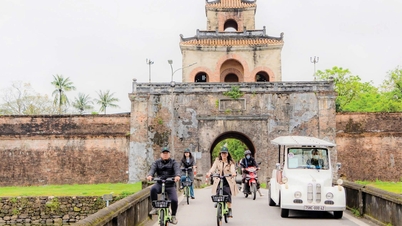
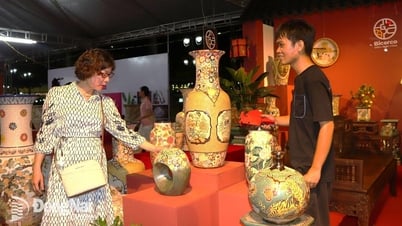
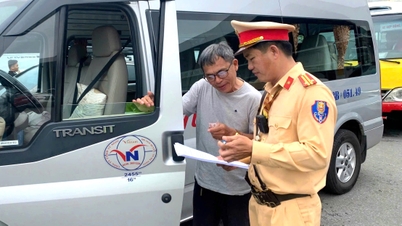


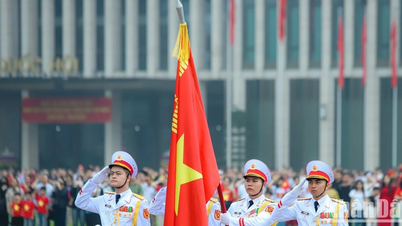





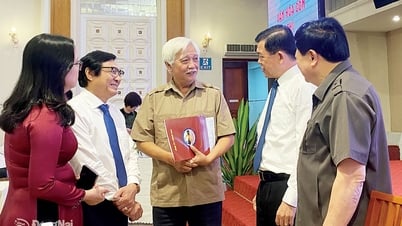
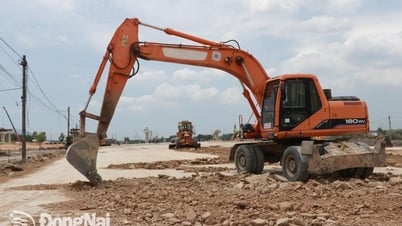

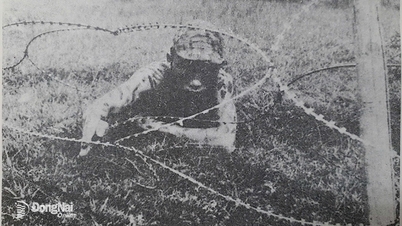

![[Photo] Chinese, Lao, and Cambodian troops participate in the parade to celebrate the 50th anniversary of the Liberation of the South and National Reunification Day](https://vphoto.vietnam.vn/thumb/1200x675/vietnam/resource/IMAGE/2025/4/30/30d2204b414549cfb5dc784544a72dee)














































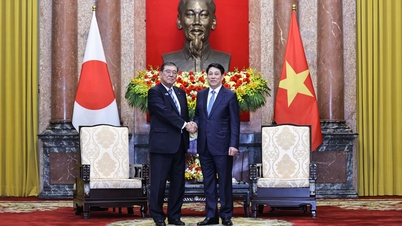



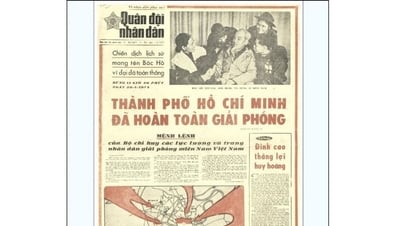



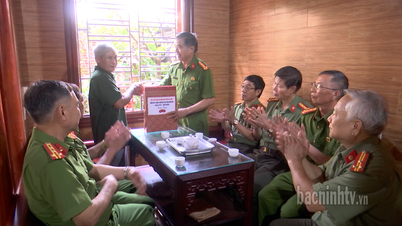
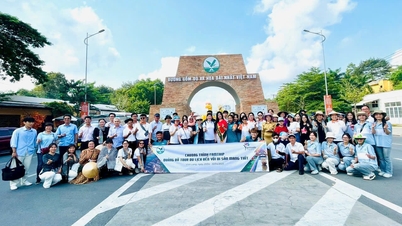














Comment (0)